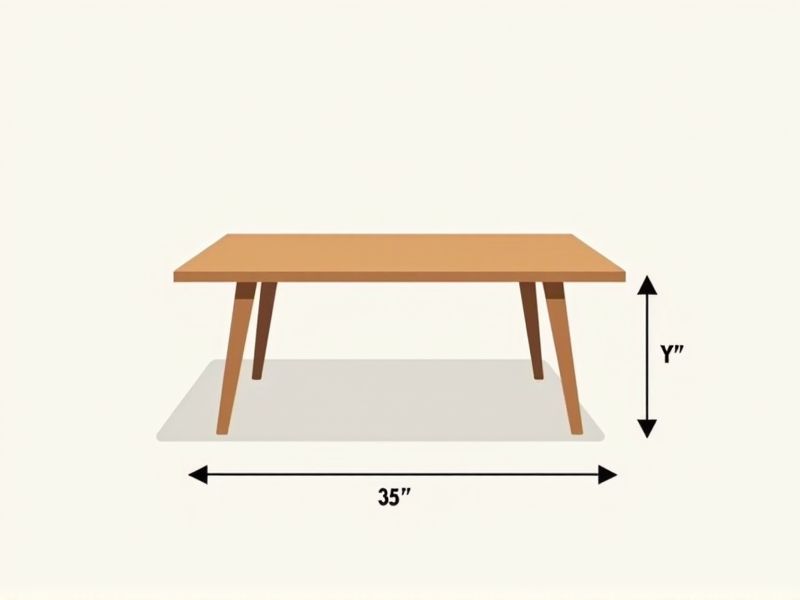
When choosing a dining table, it's helpful to know that standard dimensions typically range from 28 to 30 inches in height, which allows for comfortable seating. Common widths for rectangular tables are 36 to 40 inches to provide enough space for place settings and serving dishes. For length, a four-seater table is usually around 48 inches long, while a six-seater is often 60 to 72 inches long. Measuring your dining area and considering how many people you plan to seat regularly will ensure you select a table size that fits both your space and your needs.
Table Length
The standard length of a dining table typically ranges from 60 to 72 inches for seating four to six people comfortably. For larger gatherings, an 84 to 96-inch table can accommodate eight to ten diners, ensuring ample space for plates and arm movement. Depending on the configuration, extending tables may feature sections that can increase length up to 120 inches, ideal for family events or gatherings. When selecting your dining table, consider the available room, allowing at least 36 inches around the table for easy movement and access.
Table Width
The standard dining table width typically ranges from 36 to 48 inches, allowing comfortable seating for guests. A width of 42 inches is ideal for dining tables, providing enough space for place settings and serving dishes. For rectangular tables, ensure at least 12 inches of width per person for optimal dining experience. If you're considering a round table, a diameter of 60 inches can accommodate up to six people comfortably, enhancing your dining space's functionality and aesthetic.
Table Height
The standard height for a dining table typically measures between 28 to 30 inches (71 to 76 cm) from the floor to the tabletop. This height accommodates most dining chairs, which are generally designed to have a seat height of 17 to 19 inches (43 to 48 cm). When selecting a dining table, consider the legroom required; ideally, there should be at least 10 to 12 inches (25 to 30 cm) of space between the seat and the bottom of the table. For optimal comfort and accessibility, ensure your table and chair dimensions align with these standard measurements.
Chair Height
The standard dining chair height ranges from 17 to 19 inches, ensuring comfortable seating at most dining tables, which typically stand between 28 to 30 inches tall. For optimal ergonomics, there's usually a 10 to 12-inch gap between the seat of the chair and the underside of the table. This height ratio accommodates a variety of body sizes, promoting an enjoyable dining experience. When selecting chairs for your dining space, measuring both chair and table heights can enhance functionality and comfort.
Seating Capacity
A standard dining table typically accommodates six to eight people, making it ideal for family gatherings and entertaining guests. Tables designed for smaller spaces generally seat four, while larger options can extend to ten or more with the use of leaves or extensions. When selecting a table, consider that each diner ideally requires about 24 inches of table width for comfortable seating. To enhance your dining experience, choose a height between 28 to 30 inches, which is standard and allows for easy access to meals and conversation.
Table Shape
The shape of a dining table plays a critical role in both aesthetics and functionality, with rectangular, round, square, and oval being the most common choices. Rectangular tables, often measuring 72 to 84 inches in length, are ideal for larger gatherings, accommodating up to 8 people comfortably. Round tables, available in diameters ranging from 48 to 72 inches, promote conversation and intimacy, making them perfect for smaller spaces. For versatility, square tables that are typically 36 to 60 inches on each side offer a modern look while being adaptable to various seating arrangements.
Leg Room
When selecting a dining table, the standard legroom is typically around 24 to 30 inches from the tabletop to the floor, ensuring comfort for diners. This measurement allows adequate space for individuals to maneuver their legs freely while seated. A standard dining chair height, ranging from 17 to 19 inches, complements this legroom effectively. For optimal dining experiences, consider tables that offer at least 12 inches of clearance between the chair seat and the underside of the table.
Overhang
The standard overhang for a dining table typically measures between 8 to 12 inches on each side, allowing for comfortable legroom and easy access while seated. This overhang ensures that when dining chairs are pushed under, the table remains accessible without compromising space. For a standard table height of 28 to 30 inches, optimal clearance is essential for both comfort and functionality. Ensuring your dining table adheres to these overhang standards enhances both the aesthetic and practicality of your dining experience.
Table Thickness
Table thickness is a crucial factor in determining the durability and aesthetic appeal of a dining table. A standard thickness typically ranges from 1 to 1.5 inches, offering a balance between sturdiness and elegance. Thicker tables, around 2 inches, provide enhanced stability, particularly for larger surfaces, while those under 1 inch may compromise on durability. Choosing the right thickness ensures that your dining table can withstand everyday use and complements your interior design seamlessly.
Allowance For Movement
A dining table should ideally provide a minimum clearance of 36 inches around all sides, allowing for comfortable movement and accessibility. This space ensures that chairs can be pulled out easily, accommodating dining guests without feeling cramped. When seating multiple individuals, tables measuring 60 to 72 inches in length can comfortably serve six to eight people, optimizing space while enhancing the dining experience. Your choice of table shape--round, rectangular, or square--can also influence the overall flow and interaction during meals, so consider how it fits within your dining area layout.
